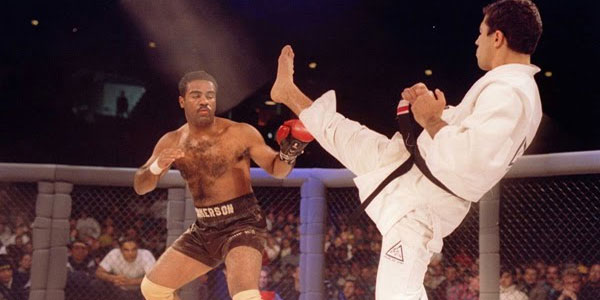The Strange History of MMA: Part 1
Posted: May 26, 2016
Updated: October 6, 2017

The strange history of MMA is one of the most unique stories in sports. This article looks back on the early days of the UFC, and how it began to form into the global phenomenon it is today.
The first UFC event was held in Denver Colorado on November 12th, 1993. It was billed as the ultimate clash of martial arts, a unique chance to see whose style would win in a fight with very limited rules. The tournament bracket was created with volunteers from all different backgrounds, and the winner was guaranteed $50,000. No one in the audience knew what to expect that night, or how that first event would impact the world of martial arts and sports forever.
The first fight at UFC 1 was between an American-born sumo wrestler named Teila Tuli and a Dutch kick boxer named Gerard Gordeau. The two fighters were different in almost every way. Tuli was short and overweight, Gordeau tall and lanky. The bell rang for the fight to start and Tuli charged straight at Gordeau, seemingly unaware that this was not a sumo competition. The Dutchman stepped to the side, and as Tuli turned back towards him, kicked him square in the face. The crowd went silent.
Something seemed wrong. No one in the audience knew how to react. In less than 30 seconds, the sumo wrestler was defeated; his teeth sent flying outside the cage. That fight sent a message to the rest of the fighters who had yet to compete that night… This was not a joke.
The star of that first UFC event was a Brazilian by the name of Royce Gracie. The 6 foot tall, 170 pound Gracie was the smallest man in the tournament, and no online sportsbooks would have given him good odds to make it through the first round, let alone win the tournament. He did just that, however, utilizing his expertise in what is now referred to as Brazilian Jiu Jitsu. He was able to take all of his opponents to the ground, and force them to submit using a joint lock or chokehold. This tournament was one of the most meaningful events in the strange history of MMA.
The inception of Brazilian jiu jitsu
Before UFC 1, most people thought boxing was the most effective form of fighting. Grappling martial arts had been dismissed by many who imagined a punch to the face was the only path to victory in a fight. Royce Gracie disproved this theory by beating three opponents in one night, one of whom was a profession boxer. The amazing thing was that Gracie hardly punched his opponents at all. In fact, most of them did not get a single scratch.

Brazilian Jiu Jitsu is all about using skill and technique to overcome size and strength. It was meant as a self defense tool for smaller people to be able to defend against a bigger attacker. UFC 1 was a wakeup call to everyone that unless you know how to defend yourself on the ground, you will be in trouble.
When UFC 2 was announced, Royce Gracie was no longer the massive underdog. In fact, Gracie became the favorite to win the tournament. Once again, Gracie used his skills on the ground to defeat each of his opponents. The effectiveness of Jiu Jitsu was now apparent. Every fighter began training in grappling, hoping that if they were matched against Gracie they could defend themselves.
The formation of mixed martial arts
Before the term mixed martial arts was coined, most people referred to MMA as “cage fighting,” or “ultimate fighting.” In 1998, people began to realize that there is no fighting style that is the most effective. In reality, the best fighting style is to be adept in everything. The early dominance of Jiu Jitsu specialists was eventually thwarted by tough wrestlers with submission defense, who were eventually beaten by strikers who could keep the fight standing.
UFC 14 was a significant event in the strange history of MMA. At the time, Mark Coleman was the UFC heavyweight champion. He had dominated all of his opponents with high level wrestling and incredible strength. His opponent that night was Maurice Smith, a former kickboxing champion who had been struggling to adjust to mixed martial arts.

On this night, Smith put all of his skills together. He was able to withstand the early onslaught from Coleman, and began to take over as the wrestler fatigued. With a combination of lightning fast punches and vicious leg kicks, Maurice Smith defeated Mark Coleman and became the UFC heavyweight champion. This fight marked the first time that a striker defeated a wrestler, and set the blueprint for future fighters, and champions, to follow in the future.
The first stars emerge
Before the year 2000, there were no real stars in the UFC. Many fighters had gained popularity, but MMA was still largely a fringe sport, and no one had managed to draw the attention of any mainstream media outlets. That all changed in 1999.

Tito Ortiz had made his UFC debut in 1997 by fighting twice in one night. He had mixed results in that tournament, beating Wes Albritton before losing by submission to Guy Mezger. Ortiz would return to the UFC just a year and four months later, and this time made an impact. He became the first fighter to show a personality that fans cared about. His nickname, “the Huntington Beach bad boy” was due to his image as a fighter willing to ruffle some feathers.
Whether you hated or loved him, you wanted to watch Tito Ortiz fight. He became the face of the UFC, and would go on to take part in some of the biggest rivalries in the strange history of MMA.
Part 2 of the strange history of MMA will focus on Zuffa’s purchase of the UFC, and some of the notable rivalries that helped to grow the sport. Leave your comment below, and make sure to check out GamingZion’s online gambling news in the US for information on everything related to betting on MMA.
















